In a world dominated by technological advancements and fast-paced lifestyles, the essence of arts and culture stands as a beacon of humanity’s collective spirit and creativity. From ancient civilizations to modern societies, art’s and culture have played a pivotal role in shaping identities, fostering connections, and enriching lives. Let’s delve deeper into the profound significance of art’s and culture in our society.
Importance of Arts and Culture in Society
Enhancing Creativity and Innovation
Arts and culture serve as catalysts for creativity and innovation. Through various artistic expressions, individuals are encouraged to think outside the box, explore new perspectives, and push the boundaries of conventional thinking. Whether it’s through painting, music, dance, or literature, artistic endeavors inspire innovation in fields ranging from technology to business.
Preserving Heritage and Identity
One of the most significant roles of arts and culture is the preservation of heritage and identity. Cultural traditions, rituals, and artistic practices are passed down from generation to generation, serving as a link to our past and a guide for the future. By celebrating cultural diversity and honoring ancestral legacies, art’s and culture contribute to a sense of belonging and collective memory.
Various Forms of Arts and Culture
Arts and culture manifest in a myriad of forms, each offering a unique insight into human expression and creativity.
Visual Arts
From ancient cave paintings to contemporary masterpieces, visual arts encompass a wide array of mediums and styles. Painting, sculpture, photography, and graphic design are just a few examples of how artists communicate their ideas and emotions through visual representations.
Performing Arts
The stage comes alive with the magic of performing arts, encompassing theater, dance, music, and beyond. Through live performances, artists captivate audiences, evoke emotions, and create memorable experiences that transcend language and cultural barriers.
Literature
Words have the power to transport us to distant lands, evoke deep emotions, and challenge our perspectives. Literature, in its various forms such as novels, poetry, and essays, offers a window into the human experience, providing insights into different cultures, societies, and historical periods.
The Intersection of Arts and Culture with Technology
In an increasingly digitized world, technology has revolutionized the way we create, consume, and interact with art’s and culture. From virtual art exhibitions to online literary magazines, digital platforms have democratized access to artistic content, allowing individuals from diverse backgrounds to engage with cultural experiences like never before.
Challenges Facing Arts and Culture
Despite its profound impact, arts and culture face various challenges that threaten their sustainability and accessibility.
Funding and Support
Limited funding and resources pose significant barriers to the growth and viability of arts and cultural institutions. Without adequate financial support, artists struggle to pursue their craft, and cultural organizations find it challenging to sustain their operations and reach wider audiences.
Accessibility and Inclusivity
Inequities in access to arts and culture perpetuate social divides and exclude marginalized communities from participating in cultural experiences. Addressing barriers such as economic disparities, physical accessibility, and language barriers is crucial to ensuring that art’s and culture are inclusive and accessible to all.
Initiatives and Solutions
Despite these challenges, numerous initiatives and solutions are emerging to support and promote arts and culture in our society.
Public Funding and Grants
Government funding, grants, and subsidies play a vital role in supporting artistic endeavors and cultural institutions. By investing in the arts, policymakers can foster creativity, promote cultural diversity, and stimulate economic growth in communities.
Community Engagement Programs
Community-based arts programs and initiatives empower local residents to participate in cultural activities, collaborate with artists, and contribute to the cultural vibrancy of their neighborhoods. Through workshops, performances, and public art projects, these programs foster community cohesion and pride.
Digital Platforms and Virtual Experiences
The rise of digital platforms and virtual experiences has revolutionized the way we engage with arts and culture. Online galleries, virtual tours, and interactive exhibits offer immersive experiences that transcend geographical boundaries, allowing individuals to explore diverse cultural heritage from the comfort of their homes.
Conclusion
Arts and culture are not mere luxuries but essential components of a thriving and vibrant society. They inspire creativity, preserve heritage, and foster connections across communities and generations. By investing in art’s and culture, we can create a more inclusive, innovative, and enriching world for all.

